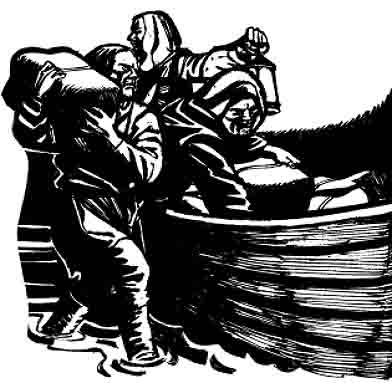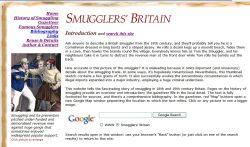Discovering Saltburn's rich heritage - Smuggling.
Saltburn's more covert history lies in smuggling and the town is immensely proud of its famous smuggling past, but does it have reason to be so?
- "Five-and-twenty ponies,
- Trotting through the dark -
- Brandy for the Parson,
- 'Baccy for the Clerk;
- Laces for a lady; letters for a spy,
- And watch the wall, my darling, while the Gentlemen go by!"
- Rudyard Kipling
Smugglers Song by Rudyard Kipling. Read by Caroline Young and distributed under Creative Commons Licence.
Saltburn Smugglers - cheerful rogues or criminal privateers?
The coastline from Whitby to Saltburn by the Sea has long been famed for its smuggling activities. Houses in these tiny coastal communities pile one on top of another and it was easy for contraband to be passed from one house to the next without it appearing above ground. Secret rooms were also built into some of the houses so that smugglers could hide from the Excise men.
Smuggling itself was an accepted way of life for English coastal villages in the late 18th and early 19th Century and it was an activity performed by all sorts of people across the social scale from farmhands to clergymen to local gentry. Entire villages would turn out to help hide the contraband goods before the arrival of the preventive officers. Folklore and local legend depicts the smugglers as harmless men, who were merely trying to avoid paying an unlawful tax.
Saltburn and other villages like it were remote and isolated communities where hidden beaches meant unlawful business could be carried on far from prying eyes. Saltburn itself is ideally situated for smuggling as the cliffs provide an effective hiding place and the wooded coves provide cover for offloading cargo. The peak of smuggling activity was over a 150 year period from 1700 and towards the end of the 18th Century, the Saltburn - Whitby area became notorious as a smuggling hotspot.

During this time England fought various expensive wars, particularly against America and France and the Government imposed heavy taxes on imported goods such as gin, tea, brandy and textiles to raise funds. Smuggling was the way to avoid taxation.
Tales of how the local community out-witted the customs officers soon became part of local folklore. One tale has an old woman hiding a keg of spirits underneath her skirts whilst customs officers performed a spot raid of her house. Another tale tells of a mother who found herself victim of a surprise search wrapping a jar of spirit in her baby's clothes, and walking past the guards with it cradled in her arms.
Saltburn's most famous smuggler was John Andrew. Born in Scotland, John Andrew moved to Saltburn and became landlord of the village's Ship Inn in 1780. Andrew's Scottish family were wealthy and well connected and in Saltburn he was a respected member of the community. He entered into a partnership with a local brewer and co-ordinated the area's smuggling trade from the Ship Inn and the White House. His grand daughter christened him 'King of the Smugglers' and he came close to being arrested on a number of occasions. He managed to combine being one of the areas most prolific criminals with a position in the branch of the local militia which was occasionally called upon to help the customs officers in their pursuit of the smugglers!
The quaint picture of smugglers perpetuated by folklore often belies the reality of the times. Battles between the customs men and the smugglers were frequent, fierce and violent and severe injuries were often sustained during these altercations. Legend and folklore portray the smugglers as lovable rogues. However, primary source material tells us a very different story, one of violent men prepared to assault and bludgeon those whose job it was to prevent their illegal trade. Which is the true picture? The likelihood is that there is an element of truth on both sides. The legends have survived and developed, forgetting or simply ignoring the more violent and unsavoury aspects of the smuggling trade, allowing us to empathise with those 'local heroes' who were, in reality, no more than criminals intent on practicing their illegal trade. Whatever your perspective smuggling was an integral part of life in 'Old Saltburn'.
 Smugglers Britain
Smugglers Britain
This website tells the fascinating story of smuggling in 18th and 19th century Britain. Pages on the history of smuggling
provide an overview and introduction; the gazetteer fills in the local detail. The text is fully footnoted for sources,
and there's a comprehensive bibliography.
A book about John Andrew called 'Watch the Wall my Darling' has been written by author Richard Swale who describes it as 'faction'. The facts have been provided by John W. Andrew and the fiction by Richard himself. Both are the great, great, great grandsons of John Andrew and James Law, both well known smugglers on the North Yorkshire coast although there is no evidence that the two actually met. The story follows the career of the two smugglers, and although not a strictly true account, gives a vivid picture of the characters, living conditions, and the tough times in which they lived. Tony Lynn, Saltburn's local historian, describes the book as easy to read but hard to put down, being good value at £5.95 and a thoroughly enjoyable read. The book is now available locally, copies are currently available at the Guisborough Bookshop.
The Saltburn Smuggler's Heritage Centre
Redcar and Cleveland Council closed the Saltburn Smuggler's Heritage Centre after a severe storm breached the sea wall and caused serious damage. There are no plans to re-open another Smuggler's Heritage Centre.
Research by Rebecca Hilton. Collecting primary source materials, articles and extracts from books related to the development of both Saltburn's and trying to validate them has offered conflicting information, much of which is often difficult to validate as many sources can prove to be unreliable e.g. newspapers or census data. Every effort has been made to ensure that the information on the history of the town presented here is as accurate as possible.
